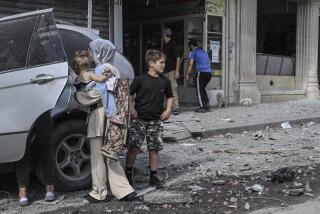Japanese nuclear plant continues to leak radioactive water into ocean
- Share via
Reporting from Tokyo — Radioactive water continued to seep into the sea Monday after a failed attempt to seal the leak at the crippled Fukushima nuclear power plant using an absorbent polymer, sawdust and shredded paper.
Tokyo Electric Power Co. officials think the leak has been coming from an 8-inch crack in the concrete pit holding power cables near reactor No. 2. On Monday, Tepco said it would use a dye to try to trace the path of the leak, Kyodo News reported. Radiation levels in the pit water are an estimated 1,000 millisieverts per hour, a high but not immediately lethal dose.
Engineers also planned to begin injecting nitrogen gas into reactors No. 1, 2 and 3 in an attempt to prevent possible explosions from the buildup of hydrogen gas. Explosions at the three reactors in the first four days after the magnitude 9 earthquake and accompanying tsunami March 11 badly damaged the reactor buildings and disabled the cooling pumps that provided water to the reactors. Government officials say it may take months to fully restore the cooling systems.
Japan’s official death toll from the disaster topped 12,000 on Sunday, as about 25,000 U.S. and Japanese troops finished an intensive three-day recovery effort. The search located 78 bodies, but more than 15,000 people are still officially listed as missing. About 160,000 survivors remain in shelters.
Japan’s Red Cross and the Central Community Chest of Japan have collected more than $1 billion but have yet to distribute any cash directly to victims, prompting Chief Cabinet Secretary Yukio Edano to urge Sunday that the process be accelerated.
A Red Cross spokeswoman, Miyoko Kawamura, responded that the payments would likely start this month.
Edano also said that the government would have independent experts retest the soil around the Fukushima nuclear plant to reevaluate whether current evacuation orders should be modified. The government has told residents living within 12 miles of the plant to evacuate, and has urged those living within 18 miles to leave or at least stay indoors as much as possible.
The government has come under renewed pressure from groups, including Greenpeace, to expand its evacuation area, but at the same time, residents who vacated the 12-mile zone have been seeking permission to return briefly to their homes to gather personal items. Officials in recent days have not shown signs of moving in either direction, and Edano said Sunday the current order will last “a long time,” though he conceded it was “tough on residents.”
Edano added that the government had checked the thyroid function of 900 children up to age 15 in two villages, Iitate and Kawamata, just outside the 18-mile perimeter and none showed signs of exposure to high radiation levels. High levels of radiation have been detected in the water and on grass in Iitate. Edano said it was the third time that the government had conducted tests on children in areas just outside the 18-mile zone.
The Red Cross has sent more than 200 emergency relief teams to the disaster zone and organized thousands of volunteers to assist victims. But no displaced people have yet received cash payments from the pot of more than $1 billion collected by the Japanese Red Cross and Red Crescent Societies and the Central Community Chest of Japan.
In past disasters in Japan, independent panels in each prefecture have determined who gets such aid and how much. Edano suggested that this time, the process must be streamlined.
“Normally donations are disbursed through local governments that rely on independent committees to decide on the conditions for dividing up the money,” Edano said. “But this time, the central government has a role to play in setting up an independent committee” that will figure out how to split up donations.
Tomohide Atsumi, president of the Nippon Volunteer Network Active in Disaster, said the Red Cross has “a policy of equity and places a high value on equality, and it takes times to assess damages.”
In contrast, he said, donations to nonprofit groups often get spent immediately. Atsumi said his organization used funds collected right after the disaster to buy underwear and other supplies for evacuees and to charter a bus for volunteers to help victims in the northeast.
Overall, he said, Japan is still learning how to strike the right balance between order and a more free-form approach in its disaster relief efforts. An overemphasis on organization and top-down decision making, he said, probably prevented more volunteers from going to the disaster zone more quickly.
“The drive to be organized is very strong in our society… but people are not good at socially improvising,” he said. “I like to use the metaphor of classical music vs. jazz. Our traditional disaster response is like classical music — there’s a conductor, a big orchestra, a fancy hall. Disaster relief should be more like jazz — you can do something with one trumpeter, one drummer. You don’t need a whole orchestra.”
As the disaster zone has become more accessible, experts are learning more about the size and force of the massive tsunami.
A group of researchers led by Yoshinobu Tsuji of Tokyo University’s Earthquake Research Institute has been studying the tsunami-hit area around Miyako, in Iwate prefecture. They found evidence that the waves could have been as high as 124 feet, according to public broadcaster NHK. That would make them the tallest waves to hit Japan’s northeastern shore since 1896, when the tsunami waves recorded at Ofunato were 125 feet high.
“This tsunami was comparable to the [1896] tsunami — and it might have been bigger,” Tsuji said.
Hall is a special correspondent. Times staff writer Thomas H. Maugh II in Los Angeles contributed to this report.
More to Read
Sign up for Essential California
The most important California stories and recommendations in your inbox every morning.
You may occasionally receive promotional content from the Los Angeles Times.











